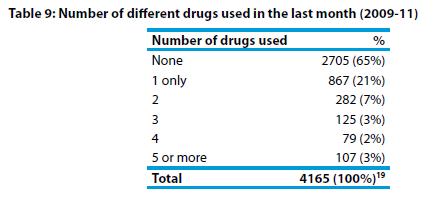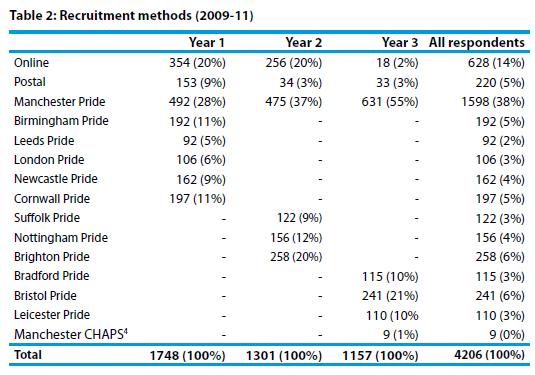Are gay people seven times more likely to take drugs than the general public?
"Gays 'seven times more likely to take illegal drugs than general population'"
Mail Online, 24 September 2012
"Drug use 'seven times higher' among gays"
Independent, 24 September 2012
Join 72,953 people who trust us to check the facts
Sign up to get weekly updates on politics, immigration, health and more.
Subscribe to weekly email newsletters from Full Fact for updates on politics, immigration, health and more. Our fact checks are free to read but not to produce, so you will also get occasional emails about fundraising and other ways you can help. You can unsubscribe at any time. For more information about how we use your data see our Privacy Policy.
"GAY people are seven times more likely to use drugs than the rest of the population."
Daily Star, 24 September 2012
This morning readers of the Mail, Independent and Star may have been startled to learn that lesbian, gay and bisexual (LGB) people are seven times more likely than the general public to have taken drugs - or more specifically illegal drugs in the past month.
At least, that's what a three-year study conducted by the Lesbian and Gay Foundation (LGF) and the University of Central Lancashire (UCLAN) claimed to have found earlier this year. Their report was published back in July, but only seems to have come to national attention this morning.
It was great to see that not only was the report published, but it contained an excellent breakdown of the sampling methods and methodology used to arrive at the results.
Let's establish first what LGF and UCLAN found. The study sampled over 4,000 people - what the LGF informed us was the "largest ever sample of LGB people asked about their drug and alcohol use". These people were all either self-identified as gay, lesbian or bisexual (some data was missing for some).
Via a questionnaire that asked about respondents' drug use in the previous month, the research found that 65 per cent of the sample did not admit to taking any illegal drugs in the past month. 35 per cent had taken at least one such drug:

The researchers then compared this to statistics from the British Crime Survey (BCS) 2010/11 which tries, among other things, to measure the proportion of 16-59 year-olds who have taken drugs in the past month. Table 2.3 from the BCS shows that 4.8 per cent of 16-59 year-olds admitted to illicit drug use in the previous month for 2010/11.
By this calculation, a 35 per cent incidence among LGB persons and a 5 per cent incidence among the population as a whole does indeed suggest that LGB people are seven times more likely to have taken drugs in the past month.
But that's where the problems start.
A familiar problem with estimating drug use is that it tends to under-report the problem. The BCS outlines several caveats to its data, such as missing the homeless or those in prison, and more significantly that respondents may not report their behaviour honestly or recall it accurately.
The BCS tackle this to an extent by asking respondents to self-complete the surveys following a face-to-face interview. This is the same method used by the LGF and UCLAN, so while we should bear the caveats in mind this isn't to suggest their questions will have yielded less honest answers than the BCS.
The trouble starts when we look at LGF's sample. While the research sampled over 4,000 people across three years, how the sample was gathered is also revealed:

81 per cent of the sample is gathered from attendees at Pride events, with the remainder gathered through online and postal surveys. LGF confirmed to Full Fact that the online survey was available to visitors of their website, and thus was also a 'self-selecting' sample.
The problem here is that there's no way to know that the sample is representative of LGB people. Self-selecting samples aren't fair representations of the population they're trying to sample because only certain types of people tend to participate. In this case, Pride attendees make up the overwhelming majority of the sample, and aren't necessarily typical of all LGB people.
The LGF defended their methods to Full Fact after we contacted them with our concerns. They responded that:
"Respondents were recruited using a range of convenience methods that were thought most likely to generate responses from LGB people. As the largest ever sample of LGB people asked about their drug and alcohol use, the data represents the best available estimate of drug and alcohol use of LGB people in England as a whole.
"Given that sexual orientation is still not recorded in many large-scale surveys, including the 2011 Census, it is difficult to get a representative sample of LGB people, and so the chosen recruitment methods were used.
"Analysis of the Part of the Picture [the name of the research] data on drug use by recruitment method suggests that the high rate of reported last month-drug taking amongst the sample as a whole cannot be explained by convenience sampling strategy and the large number of users recruited via Pride events. Pride respondents were no more likely to have taken any drug in the last month than any other group of respondents and for some substances they were the least likely.
"The report's findings are striking and should be a wake-up call for people working with the LGB community and for policy makers commissioning services at a local and national level."
It's correct that the LGF test their sampling methods (postal, online, Pride) next to each other and get similar proportions of drug use for each. But this doesn't change the fact that all the methods are self-selecting.
In other words, we don't have a good reason to think three concurrent but flawed sampling methods are representative of who they are claiming to represent.
Alternative research
The Home Office directed Full Fact to an extension of the British Crime Survey in 2009/10 and 2010/11 in which they questioned 985 lesbian, gay and bisexual people about their drug use in the past year.
This found that:
"Compared with heterosexual adults, gay or bisexual adults were more likely to have taken any drug (10.0% and 32.8% respectively) or any Class A drug (3.6% and 11.1% respectively) in the last year"
Again, this is subject to the BCS caveats we've already mentioned, but it does tell us something interesting. As far as we know, lesbian, gay and bisexual people are more likely to have taken illicit drugs in the last year than the general population based on the best methods we have available.
So the point being made by the LGF and UCLAN research is quite possibly a valid one - but it is not their figures which justify their point. The evidence from the BCS suggests there is a greater likelihood, but there is not such a significant difference as implied by the LGF research.
Update (25 September 2012)
This article has been amended to add to the LGF's statement in response to our analysis, in particular to point out that it is difficult to attain a representative sample based on sexual orientation, hence the choice of recruitment method.